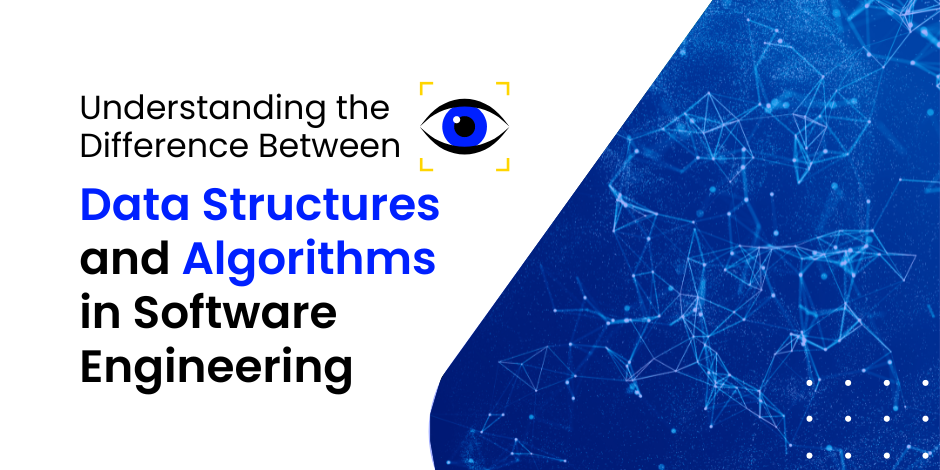Understanding the Important Difference Between Data Structures and Algorithms in Software Engineering

Stay Informed With Our Weekly Newsletter
Receive crucial updates on the ever-evolving landscape of technology and innovation.
Software engineering relies heavily on the integration of data structures and algorithms to solve complex problems efficiently. As a software engineer, it is crucial to understand the role of data structures and algorithms in developing robust and high-performing software systems.
Here’s a comprehensive overview difference between data structures and algorithms, their individual roles, and a comparison between them to help you gain a better understanding of their significance in software engineering.
Introduction to data structures and algorithms

Data structures and algorithms are fundamental concepts in computer science and software engineering.
Defining data structures
Data structures are containers that hold and organise data in a particular format. They provide an efficient way of storing and accessing data, which is essential for performing various operations on it.
Each data structure has its own set of rules, operations, and memory requirements, catering to different scenarios and optimising specific types of operations. These structures act as the building blocks for organising vast amounts of information in software systems.
When it comes to data structures, there are many different types to choose from. Some common examples include arrays, linked lists, stacks, queues, trees, and graphs. Each of these structures has its own unique characteristics and advantages, making them suitable for different types of data and operations.
For example, arrays are ideal for storing a fixed number of elements of the same type, while linked lists are great for dynamic data that can grow or shrink in size.
Data structures can be classified as either linear or non-linear. Linear data structures, such as arrays and linked lists, organise data in a sequential manner, where each element has a direct relationship with its neighbouring elements.
On the other hand, non-linear data structures, such as trees and graphs, allow for more complex relationships between elements, forming hierarchical or interconnected structures.
Defining algorithms
Algorithms, on the other hand, are step-by-step procedures or processes used for solving specific problems. They take input data, perform a series of operations on it, and produce the desired output.
Algorithms provide a systematic approach to problem-solving by defining a clear set of instructions or rules to be followed. They form the backbone of software systems and determine the efficiency and effectiveness of various operations performed on data.
Algorithms can be found in various aspects of our daily lives, not just in computer science. For example, think about a recipe for baking a cake.
The recipe is essentially an algorithm that guides you through a series of steps, such as mixing ingredients, preheating the oven, and baking for a specific amount of time. By following the recipe, you can consistently produce the desired outcome – a delicious cake!
In computer science, algorithms are designed to solve specific problems efficiently. They can range from simple and straightforward to complex and intricate. Some common algorithmic techniques include searching, sorting, graph traversal, and dynamic programming.
These techniques provide a foundation for solving a wide range of problems, from finding the shortest path in a network to optimising resource allocation in a computer system.
It’s important to note that the efficiency of an algorithm can vary significantly depending on its design and implementation.
The same problem can often be solved using different algorithms, each with its own trade-offs in terms of time complexity, space complexity, and other factors. As a software engineer, it’s crucial to understand these trade-offs and choose the most appropriate algorithm for a given problem.
Data structures and algorithms are essential components of computer science and software engineering. Data structures provide a way to organise and store data efficiently, while algorithms offer systematic approaches to problem-solving.
By understanding and utilising these concepts effectively, software engineers can develop efficient and robust software systems that can handle large amounts of data and solve complex problems.
The role of data structures in software engineering

Data structures play a crucial role in software engineering by providing efficient ways of organising and managing data.
Types of data structures
There is a wide range of data structures available, each tailored to specific scenarios and requirements. As previously mentioned, some common types of data structures include:
- Arrays
- Linked Lists
- Stacks
- Queues
- Trees
- Graphs
- Hash Tables
Each data structure has its unique characteristics and advantages, making it suitable for different purposes. For example, arrays provide constant-time access to elements using their index, while linked lists offer efficient insertion and deletion operations.
Practical applications of data structures
Data structures find applications in various areas of software engineering. For instance, databases utilise data structures such as B-trees for efficient storage and retrieval of data.
Data structures, like stacks and queues, are integral components of operating systems, facilitating process scheduling and memory management. Efficient algorithms for sorting and searching often rely on optimised data structures to achieve optimal performance.
The role of algorithms in software engineering

Algorithms are fundamental to software engineering as they determine how efficiently a task can be performed.
Types of algorithms
There are various types of algorithms designed to solve specific problems efficiently. Some commonly used algorithms include:
- Sorting Algorithms (e.g., Bubble Sort, Quicksort)
- Searching Algorithms (e.g., Binary Search, Depth-First Search)
- Graph Algorithms (e.g., Dijkstra’s Algorithm, Kruskal’s Algorithm)
- Hashing Algorithms (e.g., SHA-256, MD5)
- Dynamic Programming Algorithms (e.g., Fibonacci Sequence)
Each algorithm has its own set of rules and complexities, determining its efficiency in solving specific problems. For example, sorting algorithms vary in their execution time and space requirements, which affects their suitability for different-sized datasets.
Practical applications of algorithms
Algorithms are essential for various software engineering tasks. For instance, search engines employ sophisticated algorithms to process and rank massive amounts of web content efficiently. Encryption algorithms also play a crucial role in securing data during communication and storage.
Moreover, image processing algorithms enable image recognition and manipulation, empowering applications like facial recognition and computer vision.
Difference between data structures and algorithms

Put simply, data structures refer to the organisation and storage of data, while data algorithms are sets of instructions that outline how to perform specific tasks or operations on that data in a step-by-step manner.
Similarities between data structures and algorithms
Both data structures and algorithms play significant roles in software engineering and rely on each other to achieve efficient solutions. They are complementary and intertwined concepts that work together to optimise software systems.
Differences between data structures and algorithms
The main difference lies in their focus and functionality. Data structures are concerned with organising and storing data, while algorithms focus on solving problems and manipulating data. Data structures provide the foundation for algorithms to operate efficiently by structuring and managing the underlying data.
Case studies: Data structures and algorithms in action
Let’s delve into some real-world case studies to understand how data structures and algorithms are applied in software engineering:
Data structures in database management
Database management systems heavily rely on data structures to store and organise vast amounts of structured data. Indexing techniques, such as B-trees, enable quick data retrieval by efficiently locating records based on search criteria.
Additionally, graph data structures represent relationships between entities, allowing efficient traversal and analysis of complex data models.
Algorithms in search engines
Search engines, like Google or Bing, utilise sophisticated algorithms to process and rank web pages based on their relevance to user queries.
These algorithms analyse and extract valuable information from massive datasets, considering factors like keyword usage, backlinks, and user behaviour. By employing efficient search algorithms, search engines provide users with relevant search results in a fraction of a second.
Conclusion
Data structures and algorithms are fundamental concepts in software engineering, intricately woven together to enable efficient problem-solving and data manipulation.
Understanding the difference between data structures and algorithms is crucial for software engineers to develop optimised software systems. By employing appropriate data structures and algorithms, developers can create robust and high-performing applications that meet the growing demands of the digital age.
If you’re looking to expand on your knowledge of data structures and algorithms to learn how they can be used to develop optimised software systems, then take a look at the short courses on offer at The Institute of Data.
You can also take advantage of our free career consultations with our local team to see where your career could take you.




